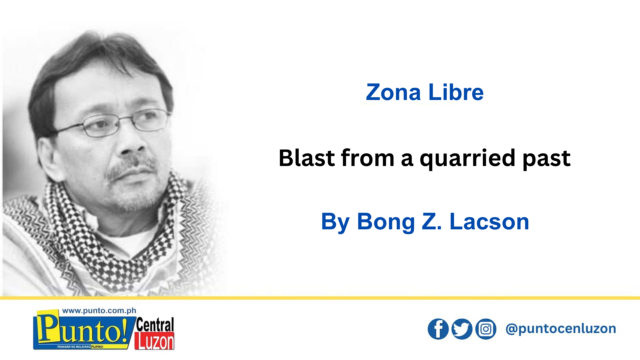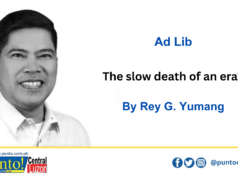P40-M IN REVENUES AT RISK.
No less than Engr. Romeo “Buddy” Dungca, chief of the provincial quarry regulatory unit KALAM (Kapampangan a Lulugud at Matapat), has sounded the alarm over the immense losses to be impacted upon Pampanga if the shutdown of 40 quarry sites in Porac which the operators themselves imposed take the full 15 days they set.
“Nakiusap lang tayo kung pwedeng pag-usapan. Hindi natin pwedeng ihinto nang matagal yan. ‘Yan ang utos sa amin ni Gov Nanay dahil diyan kumukuha ang Kapitolyo sa pantulong niya sa mga Kapampangan,” the former multi-term Bacolor mayor noted in an interview with media persons last Monday, Nov. 24, with the closure of quarry sites into its fourth day.
That sand quarrying takes premium among the locally sourced incomes for Pampanga is solidified in numbers at the Office of the Provincial Treasurer: P5 billion from 2019 to 2025, directly translating to P714,285,714 per year, P59,523,809 per month, P1,984,126 per day.
That despite this massive contribution to the provincial coffers – and undoubtedly, fattening their bank accounts too – the operators and haulers decided to shut down all operations impacts the gravity of their grievance against the Porac local government, notably Mayor Jing Capil, on allegations of double taxation, arbitrariness in policies and processes especially in issuing clearances, and outright harassment.
In the great scheme of things, the Porac quarry dispute is but a ripple in the otherwise all-too-smooth state of the quarry industry since the ascendancy to the Capitol of Gov. Lilia “Nanay” Pineda in 2010 and through her three terms, onto the tenure of Gov. Dennis “Delta” Pineda from 2019, and now back to Nanay Gov.
There is some dynamics manifesting here, a recurrence that just made me hark back to the Capitol’s management of quarrying pre-Pineda times. Here’s something risible published here Oct. 10, 2007:
Defining ‘Q’
QUARRY (1). n., pl – ries. 1. A bird or animal hunted; prey; game. 2. Any object of pursuit (Middle English querre, entrails of a beast given to the hounds, from Old French cuiree, variant of co(u)ree, from Late Latin corata, viscera, from Latin cor, heart.
Quarry (2). n., pl – ries. An open excavation or pit from which stone is obtained by digging, cutting or blasting. – tr.v. quarried, -rying, -ries. 1. To cut, dig, blast or otherwise obtain (stone) from a quarry. 2 To use land as a quarry. (Middle English quarey, quarere from Old French quarriere from quarre (unattested), “square stone” from Latin quadras, square.
The lexicographic definitions of the word quarry – the Grolier International Dictionary used here – are too clear for any misunderstanding. (What? No mention of sand in the definition? Well, sand, along with marble, mayhaps only came later to join stone as materials being quarried.)
Well-defined as it is, still – in Pampanga – the word quarry has assumed myriad connotations and varied denotations well outside the parameters of its dictionary meaning.
It was not so long ago that the word quarry meant all of these things: some tracts of lands and fishponds, some choice lots in premier subdivisions, condo units along Manila Bay, and the heart of a Mutya ning Kapampangan finalist.
In that same period, quarry assumed the synonyms of top-of-the-line sports-utility vehicles like Lincoln Navigators and Humvee 2s, luxurious S-type Mercedes Benzes and 7-series BMWs. Forget the Pajeros, they were for paisanos. The Patrols, to the bodyguards as back-up vehicles
Still then too, quarry connoted grand palaces and stately mansions sprouting in rustic Porac.
Ah, those attributions were well within our first dictionary entry of the word: “object of pursuit.” The pursuers making prey of the collection pot for their own ends.
In our common understanding, quarry meant digging. For sand, that is. Still, misunderstanding persists.
Again, an instance in the recent past.
Threatened with suspension over the reported indiscriminate quarrying in his town, my once favorite mayor, rolled his Rs in his spirited defense that: “There is no quarrying in Mexico. There is only the scraping of lahar from private agricultural lands in pursuit of our noble objective to make them arable again for greater productivity and prosperity of our people.”
Only scraping and not quarrying? Even when the lahar scraped was used as pantambak (filling materials) to the pinak (marshland) atop which SM City Pampanga rose?
One month after the Reverend Governor Eddie T. Panlilio took his seat at the Capitol, quarry assumed the definition of P1-million per day. And at the same time confirmed the earlier definition of quarry as unexplained wealth and plunder.
So we are now all agreed on all that the Q word stands for? Not yet.
Our good friend Mayor Buddy Dungca of Bacolor raised hell when Capitol quarry operatives known for the eponymous BALAS (Biyaya a Luluguran at Sisinupan) moniker stopped desilting operations along the Gugu Creek to relieve the waterway of the volumes of lahar that settled there after the heavy rains of August and September.
The spectre of Oct. 1, 1995 in Cabalantian was poised like Damocles’ Sword upon some barangays, thus the mayor immediately ordered and implemented sustained desilting operations.
Apparently incensed at some insinuations from the Bacolor folk that his stoppage of the operations manifested a most-unpriestly, if not inhuman side, of Panlilio, the governor hit back by declaring that what was being done was not desilting but quarrying, with the qualification that “what was dug was sold, and not used to buttress the earthen dikes or given to the residents as pantambak.”
So there, yet another qualification to the Q definition: “that which is sold.”
Truly, quarry is a very dynamic word.





